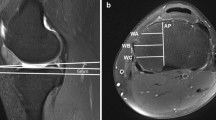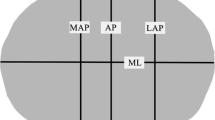Abstract
Purpose
The objective of this study was to analyze the morphology of the medial tibial plateau and lateral tibial plateau in Chinese knees and compared these measurements and features with those of commercial unicondylar tibial baseplates.
Methods
Three-dimensional knee models were reconstructed from computed tomography slices of 81 subjects. Among the series, 27 knees were from male subjects and 54 knees from female subjects. The dimensions and shape of the medial and lateral tibial plateaus were measured and compared with six commercially available unicondylar tibial baseplates.
Results
The results showed significant differences between the shapes of the medial and lateral tibial plateaus. For the lateral tibial plateau, the shape was symmetric about the mediolateral axis. The medial plateaus presented their widest mediolateral width in an obviously more posterior position than the lateral compartment. Additionally, the plateau aspect ratio decreased with increasing mediolateral dimensions, in contrast to the constant aspect ratio shown by conventional unicondylar knee prostheses.
Conclusion
Compartment-specific designs may optimize coverage between the prosthesis and resected tibial surface. The morphometrical measurements presented may allow manufacturers to design tibial baseplates that accommodate the structural variability between different ethnic groups.
Level of evidence
Prospective comparative study, Level II.





Similar content being viewed by others
References
Ashraf T, Newman JH, Evans RL, Ackroyd CE (2002) Lateral unicompartmental knee replacement survivorship and clinical experience over 21 years. J Bone Jt Surg Br 84:1126–1130
Bartel DL, Burstein AH, Santavicca EA, Insall JN (1982) Performance of the tibial component in total knee replacement. J Bone Jt Surg Am 64:1026–1033
Baré JV, Gill HS, Beard DJ, Murray DW (2006) A convex lateral tibial plateau for knee replacement. Knee 13:122–126
Chaichankul C, Tanavalee A, Itiravivong P (2011) Anthropometric measurements of knee joints in Thai population: correlation to the sizing of current knee prostheses. Knee 18:5–10
Chau R, Gulati A, Pandit H, Beard DJ, Price AJ, Dodd CA, Gill HS, Murray DW (2009) Tibial component overhang following unicompartmental knee replacement–does it matter? Knee 16:310–313
Chang TW, Yang CT, Liu YL, Chen WC, Lin KJ, Lai YS, Huang CH, Lu YC, Cheng CK (2011) Biomechanical evaluation of proximal tibial behavior following unicondylar knee arthroplasty: modified resected surface with corresponding surgical technique. Med Eng Phys PMID: 21741289
Cheng FB, Ji XF, Zheng WX, Lai Y, Cheng KL, Feng JC, Li YQ (2010) Use of anthropometric data from the medial tibial and femoral condyles to design unicondylar knee prostheses in the Chinese population. Knee Surg Sports Traumatol Arthrosc 18:352–358
Cheng FB, Ji XF, Lai Y, Feng JC, Zheng WX, Sun YF, Fu YW, Li YQ (2009) Three dimensional morphometry of the knee to design the total knee arthroplasty for Chinese population. Knee 16:341–347
Fisher DA, Dalury DF, Adams MJ, Shipps MR, Davis K (2010) Unicompartmental and total knee arthroplasty in the over 70 population. Orthopedics 33:668
Hamilton WG, Ammeen D, Engh CA Jr, Engh GA (2010) Learning curve with minimally invasive unicompartmental knee arthroplasty. J Arthroplasty 25:735–740
Hang JR, Stanford TE, Graves SE, Davidson DC, de Steiger RN, Miller LN (2010) Outcome of revision of unicompartmental knee replacement. Acta Orthop 81:95–98
Heyse TJ, Tibesku CO (2010) Lateral unicompartmental knee arthroplasty: a review. Arch Orthop Trauma Surg 130:1539–1548
Koskinen E, Paavolainen P, Eskelinen A, Harilainen A, Sandelin J, Ylinen P, Tallroth K, Remes V (2009) Medial unicompartmental knee arthroplasty with Miller-Galante II prosthesis: mid-term clinical and radiographic results. Arch Orthop Trauma Surg 129:617–624
Naal FD, Fischer M, Preuss A, Goldhahn J, von Knoch F, Preiss S, Munzinger U, Drobny T (2007) Return to sports and recreational activity after unicompartmental knee arthroplasty. Am J Sports Med 35:1688–1695
Pennington DW, Swienckowski JJ, Lutes WB, Drake GN (2006) Lateral unicompartmental knee arthroplasty: survivorship and technical considerations at an average follow-up of 12.4 years. J Arthroplasty 21:13–17
Sah AP, Scott RD (2007) Lateral unicompartmental knee arthroplasty through a medial approach. Study with an average five-year follow-up. J Bone Jt Surg Am 89:1948–1954
Servien E, Saffarini M, Lustig S, Chomel S, Neyret P (2008) Lateral versus medial tibial plateau: morphometric analysis and adaptability with current tibial component design. Knee Surg Sports Traumatol Arthrosc 16:1141–1145
Stulberg BN, Dombrowski RM, Froimson M, Easley K (1995) Computed tomography analysis of proximal tibial coverage. Clin Orthop Relat Res 311:148–156
Surendran S, Kwak DS, Lee UY, Park SE, Gopinathan P, Han SH, Han CW (2007) Anthropometry of the medial tibial condyle to design the tibial component for unicondylar knee arthroplasty for the Korean population. Knee Surg Sports Traumatol Arthrosc 15:436–442
Tang Q, Zhou Y, Yang D, Xu H, Liu Q (2010) The offset of the tibial shaft from the tibial plateau in Chinese people. J Bone Jt Surg Am 92:1981–1987
Uehara K, Kadoya Y, Kobayashi A, Ohashi H, Yamano Y (2002) Anthropometry of the proximal tibia to design a total knee prosthesis for the Japanese population. J Arthroplasty 17:1028–1032
Walker PS (1989) Requirements for successful total knee replacements. Design considerations. Orthop Clin N Am 20:15–29
Westrich GH, Haas SB, Insall JN, Frachie A (1995) Resection specimen analysis of proximal tibial anatomy based on 100 total knee arthroplasty specimens. J Arthroplasty 10:47–51
Yue B, Varadarajan KM, Ai S, Tang T, Rubash HE, Li G (2011) Differences of knee anthropometry between Chinese and white men and women. J Arthroplasty 26:124–130
Yue B, Varadarajan KM, Ai S, Tang T, Rubash HE, Li G (2011) Gender differences in the knees of Chinese population. Knee Surg Sports Traumatol Arthrosc 19:80–88
Acknowledgments
The authors acknowledge the financial support from the Southern Taiwan Science Park (STSP) (BY-03-04-17-98) and the National Science Council (NSC 98-2221-E-195-001 and NSC 99-2221E-195-001).
Conflict of interest
No conflicts of interest on this manuscript.
Author information
Authors and Affiliations
Corresponding author
Rights and permissions
About this article
Cite this article
Chang, TW., Huang, CH., McClean, C.J. et al. Morphometrical measurement of resected surface of medial and lateral proximal tibia for Chinese population. Knee Surg Sports Traumatol Arthrosc 20, 1730–1735 (2012). https://doi.org/10.1007/s00167-011-1749-9
Received:
Accepted:
Published:
Issue Date:
DOI: https://doi.org/10.1007/s00167-011-1749-9




